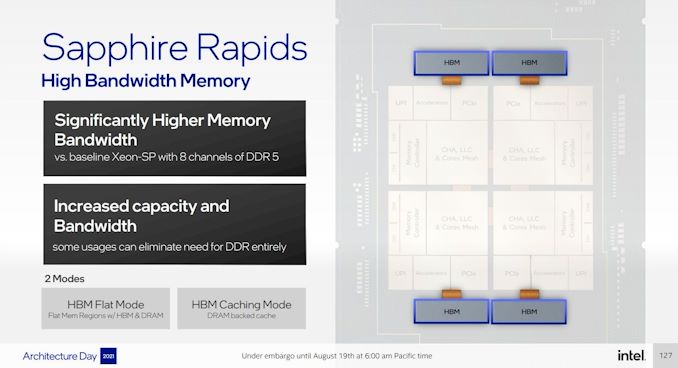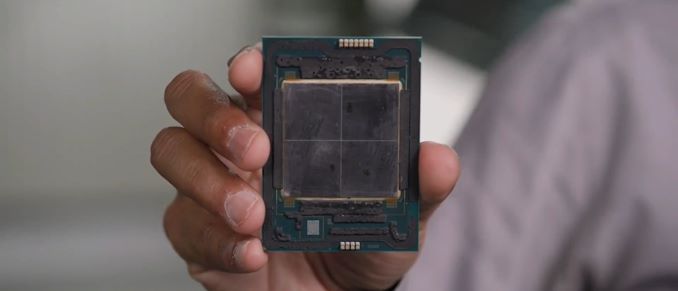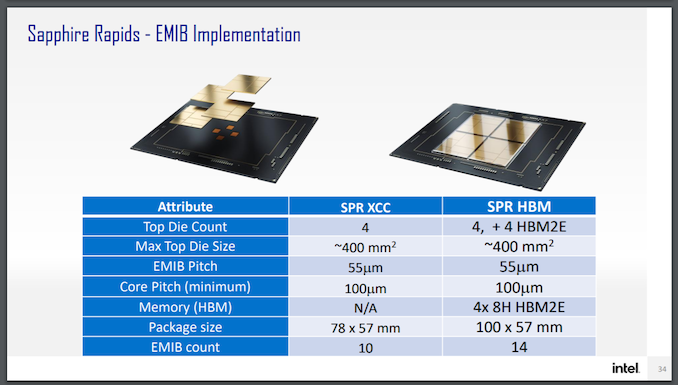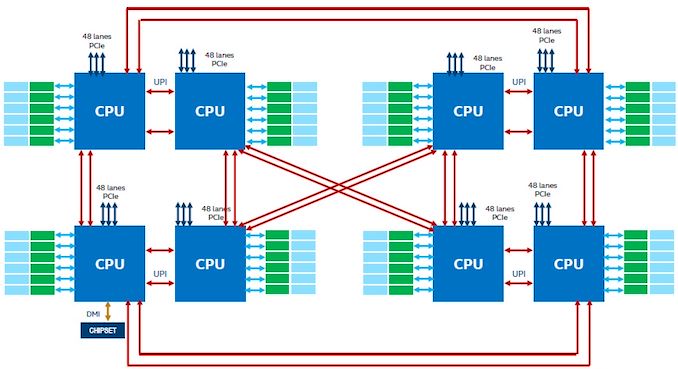Intel Xeon Sapphire Rapids: How To Go Monolithic with Tiles
by Dr. Ian Cutress on August 31, 2021 10:00 AM ESTAdd In Some HBM, Optane
The other angle to Sapphire Rapids is the versions with HBM on board. Intel announced this back in June, but there haven’t been many details. As part of Architecture Day, Intel stated that that HBM versions of Sapphire Rapids would be made public, and be made socket compatible with standard Sapphire Rapids. The first customer of the HBM versions of SPR is the Argonne National Lab, as part of its Aurora Exascale supercomputer.
This diagram it showcases four HBM connections, one to each compute tile. Looking at the package, however, I don’t think that there’s realistically enough space unless Intel has commissioned some novel HBM that is long and narrow as it is in the diagram.
Even though Intel said that the HBM variants would be in the same socket, even their own slide from Hot Chips says different.
Here the package size with HBM says 100x57mm, compared to the SPR which is 78x57mm. So unless Intel is planning a reduced version for the 78x57mm socket, it's going to be in a different socket.
It is important to note that HBM will act in a similar capacity to Optane – either as an HBM flat mode with DRAM that equates the two, or as an HBM caching mode that acts similar to an L4 cache before hitting main memory. Optane on top of this can also be in a flat mode, a caching mode, or as a separate storage volume.
HBM will add power consumption to the package, which means we’re unlikely to see the best CPU frequencies paired with HBM if it is up against the socket limit. Intel has not announced how many HBM stacks or what capacities will be used in SPR, however it has said that they will be underneath the heatspreader. If Intel are going for a non-standard HBM size, then it’s anyone’s guess what the capacity is. But we do know that it will be connected to the tiles via EMIB.
A side note on Optane DC Persistent Memory – Sapphire Rapids will support a new 300 series Optane design. We asked Intel if this was the 200-series but using a DDR5 controller, and were told that no, this is actually a new design. More details to follow.
UPI Links
Each Sapphire Rapids Processor will have up to four x24 UPI 2.0 links to connect to other processors in a multi-socket design. With SPR, Intel is aiming for up to eight socket platforms, and in order to increase bandwidth has upgraded from three links in ICL to four (CLX had 2x3, technically), and moved to a UPI 2.0 design. Intel would not expand more on what this means, however they will have a new eight-socket UPI topology.
Current eight-socket designs use a twisted hypercube topology: two groups of four form a box, and one pair is connected to the same vertex on the other set of four, while the second pair is inverted. Make sense? No, not really. Essentially each CPU is directly connected to three others, and the other four are two hops away. With the new topology, each CPU gets a direct connection to another, which moves the design more towards a fully connected topology, however exactly which CPU that connection should go to, Intel hasn’t stated yet.
Security
Intel has stated that it will be announcing full Security updates for SPR at a later time, however features like MKTME and SGX are key priorities.
Conclusions
For me, the improved cores, upgraded PCIe/DDR, and the ‘appears as a monolith’ approach are the highlights to date. However, there are some very obvious questions still to be answered – core counts, power consumption, how lower core counts would work (even suggestions that the LCC version is actually monolithic), and what the HBM enabled versions will look like. The HBM versions, with the added EMIB, are going to cost a good amount, which isn’t great at a time when AMD’s pricing structure is very competitive.
It is expected that when Sapphire Rapids is released, AMD will still be in the market with Milan (or as some are postulating, 3D V-Cache versions of Milan, but nothing is confirmed) and it won’t be until the end of 2022 when AMD launches Zen 4. If Intel can execute and bring SPR into the market, it will have a small time advantage in which to woo potential customers. Ice Lake is being sold on its specific accelerator advantages, rather than raw core performance, and we will have to wait and see if Sapphire Rapids can bring more to the table.
Intel moving to a tile/chiplet strategy in the enterprise has been expected for a number of years – at least on this side of the fence, ever since AMD made it work and scale beyond standard silicon limits, regardless of whatever horse-based binding agent is used between the silicon, Intel would have to go down this route. It has been delayed, mostly due to manufacturing but also optimizing things like EMIB which also takes time. EMIB as a technology is really impressive, but the more chips and bridges you put together, even if you have a 99% success rate, that cuts into yield. But that's what Intel has been working on, and for the enterprise market, Sapphire Rapids is the first step.














94 Comments
View All Comments
Silver5urfer - Wednesday, September 1, 2021 - link
Knights Landing was Atom based platform. Tons of Atom cores on a giant LGA4xxx socket and it died. The only reason they shoved those pathetic cores onto LGA1700 is to compete in SMT applications against Ryzen without blowing a hole in the power consumption. Once we get the TDP of these new Xeon SPR processors we will get an idea on how a 14C tile operates, they avoided going 14C on the desktop also due to scaling them onto the crappy BGA trashware where their efficiency works to combat Apple M series and AMDs APUs. That is the highest margin for Intel apart from Datacenter business of Xeon. Their desktop is lowest priority of all 3. So they do not care about that but they wasted ton of cash on that stupid Intel Thread Director.drothgery - Wednesday, September 1, 2021 - link
They've made some "lots of Atom cores" processors before; it wouldn't be too shocking if they did again. Though swapping out 14X Golden Cove tiles for 56X Gracemont tiles to build a 224-core monster seems ... improbable.Duncan Macdonald - Wednesday, September 1, 2021 - link
Power consumption ?Recent Intel CPUs have been power hogs when the frequency is raised sufficiently to start to compete with the AMD CPUs. (So much so that Cloudfare gave up on Intel CPUs in its recent servers (See https://www.theregister.com/2021/09/01/cloudflare_... for more details).)
For any large scale deployment of servers, the power consumption of the servers is as important as their performance. A quote from a Cloudflare engineer "Although Intel's chips were able to compete with AMD in terms of raw performance, the power consumption was several hundred watts higher per server – that's enormous."
Ian Cutress - Wednesday, September 1, 2021 - link
Product information not disclosed. This was an architecture presentation.TristanSDX - Wednesday, September 1, 2021 - link
no benches :(edzieba - Wednesday, September 1, 2021 - link
"This means that if SPR is going to offer versions with fewer cores, it is going to either create dummy tiles without any cores on them, but still keep the PCIe/DDR5 as required, or quite simply those lower core counts are going to have fewer memory controllers."Or these mirrored die pairs will have very aggressive stratified binning.
msroadkill612 - Wednesday, September 1, 2021 - link
Intel rely on short memories.When Zen appeared, they were notorious for forcing multi socket servers (gouging) on folks who really only needed single sockets - the exact opposite of aiming for better processor interconnects.
They know how vital tdp is as a metric.
If their solution is so competitive - why does it push the maximum acceptable tdp limits? It smacks of desperation.
wrkingclass_hero - Thursday, September 2, 2021 - link
It looks like they pulled out a dusty chip from under the fridge for that press pickwrkingclass_hero - Thursday, September 2, 2021 - link
*picAlexvrb - Sunday, September 5, 2021 - link
"The word ‘channel’ has often been interchangeable with ‘memory slot’ to date, but this will have to change."I get what you're saying, but as-worded that hasn't been true like... ever. I'm typing this on a newfangled dual channel system with 4 (count em, 4!) memory slots. I know it would be confusing to say you've got 16 x 32 bit channels for 8 or 16 modules, people might think you're only enabling half the channels with 8 modules. You could always specify double-channel modules or something of that nature.